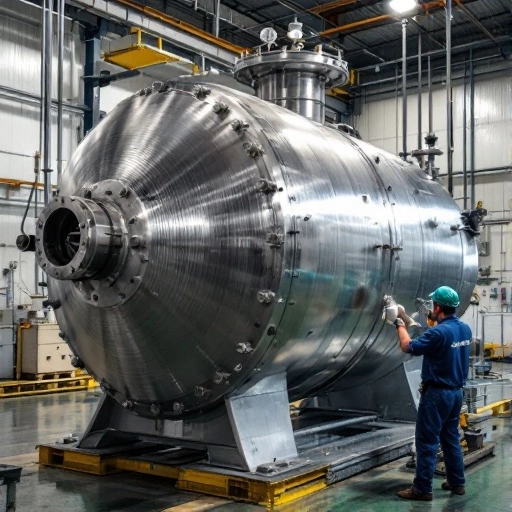
The Role of Independent Testing in Achieving OEM Compliance Vessel Testing Standards
Third-party pressure vessel testing for OEM compliance is one of the most essential steps in ensuring that fabricated vessels meet strict industry codes, safety regulations, and evolving customer expectations. In this case study, we explore how a leading U.S.-based electronics OEM implemented a robust OEM compliance vessel testing strategy by engaging third-party inspectors. This move not only revealed hidden vulnerabilities in vessel fabrication but also helped the company secure critical compliance approvals and avoid costly regulatory setbacks during commissioning.
Unlike internal QA procedures, which can sometimes overlook subtler structural or material inconsistencies, OEM compliance vessel testing conducted by independent agencies offers an unbiased, comprehensive review of every weld, pressure rating, and design feature. These external audits are especially vital when working toward high-level certifications such as ASME, API, or ISO. By partnering with an accredited third-party testing agency, OEMs gain a powerful layer of risk management—ensuring that products meet performance standards under real-world operating conditions.
OEMs operating in today’s global manufacturing environment must strike a delicate balance between speed, innovation, and regulatory accountability. OEM compliance vessel testing enables this balance by introducing objective scrutiny into the production lifecycle. Whether for pressure containment validation, material traceability, or code compliance, the impartial oversight of third-party professionals helps OEMs identify design or fabrication weaknesses that internal teams may miss—ultimately leading to safer, more reliable industrial systems.
The Compliance Gap: Internal Tests Weren’t Enough
As part of a critical facility upgrade, the OEM initiated a project focused on OEM compliance vessel testing to ensure all newly installed equipment met safety and performance standards. The company commissioned a custom batch of five pressure vessels specifically engineered for high-temperature solvent recovery applications. These vessels were designed to withstand elevated operating pressures and temperatures, making compliance testing essential before full-scale integration into the manufacturing process.
To begin the OEM compliance vessel testing process, initial evaluations were carried out in-house. However, these tests were limited in scope—consisting primarily of visual inspections and basic leak checks. While these preliminary assessments helped identify any obvious defects, they fell short of the rigorous pressure, hydrostatic, and performance testing typically required for certified pressure vessels used in demanding industrial applications. The OEM recognized that complete compliance would require a comprehensive third-party testing phase to validate each vessel’s integrity, safety, and operational readiness in alignment with national standards.
By prioritizing thorough OEM compliance vessel testing, the manufacturer aimed to minimize operational risk, ensure regulatory compliance, and lay the foundation for a safer, more efficient production environment.
However, an audit by a state regulatory body flagged the following:
- No hydrostatic test reports signed by certified inspectors
- Absence of ultrasonic or radiographic test documentation
- Incomplete material traceability logs
This scenario illustrates why third-party pressure vessel testing for OEM compliance is often mandated by industry standards like ASME BPVC, ISO 16528, and regional codes. Without certified documentation, pressure vessels may be deemed unfit for service, risking shutdowns and fines.
Furthermore, in industries involving volatile materials—like petrochemicals, pharmaceuticals, and power generation—regulators require test results from accredited agencies to mitigate the potential consequences of equipment failure.
Third-Party Testing Services Deployed
The OEM immediately engaged an independent test lab to conduct the following validations:
- Hydrostatic Testing: Pressurizing the vessel beyond operational limits to verify strength and integrity
- Radiographic Testing (RT): X-ray evaluation of weld seams to detect porosity or incomplete fusion
- Ultrasonic Testing (UT): Non-invasive assessment of wall thickness and detection of subsurface flaws
- Magnetic Particle Inspection (MT): Detection of surface and slightly subsurface discontinuities around weld zones
- Material Certification Review: Independent verification that the pressure vessel materials matched required specifications
Other optional services included:
- Positive Material Identification (PMI): Ensuring alloy compositions align with mechanical and chemical requirements
- Hardness Testing: To determine the resilience of weld zones and pressure-bearing surfaces
- Dye Penetrant Testing (PT): For fine cracks in stainless steel vessels where magnetic inspection is not viable
This comprehensive battery of tests ensured full code compliance and elevated the OEM’s confidence in vessel safety.
Benefits Realized Through Third-Party Validation
After the vessels passed all third-party tests, the OEM achieved the following:
- Official compliance certification required by their local and international clients
- Improved customer trust in the reliability of the equipment
- Mitigated liability risks by having test documentation from an accredited body
- Faster commissioning approval during the facility upgrade inspection
- Insight into vendor performance, helping future procurement decisions
In addition, the third-party report became a valuable part of the OEM’s documentation package for equipment resale and insurance audits. It served as a proof-of-quality artifact during customer negotiations and post-installation warranties.
This case reinforced how third-party pressure vessel testing for OEM compliance does more than check a box—it secures operational readiness and reputation.
The Added Value of Independent Oversight
Third-party pressure vessel testing for OEM compliance is a critical step in ensuring that every weld, material, and design element aligns with the highest industry standards. This rigorous process goes beyond basic internal quality control, offering OEMs an unbiased and professionally validated assessment of vessel integrity and safety. At the heart of OEM compliance vessel testing is the assurance that all components meet strict ASME, DOT, or other applicable regulatory codes—reducing the risk of catastrophic failure, environmental hazard, or costly shutdowns.
While internal QA systems play an important role in identifying early-stage defects, they cannot replace the value of independent verification. OEM compliance vessel testing conducted by certified third-party inspectors introduces a critical layer of accountability that protects OEMs from liability and reinforces product reliability. These external audits evaluate weld quality, material certifications, pressure integrity, and performance under operating conditions—ensuring that the vessel is truly ready for industrial use.
OEMs that prioritize third-party compliance vessel testing gain strategic advantages: improved customer confidence, smoother regulatory approval processes, and a lower likelihood of product recalls or warranty claims. In today’s competitive industrial landscape, investing in OEM compliance vessel testing is more than a legal requirement—it’s a commitment to building safer, stronger, and smarter systems that stand the test of time.
Need a reliable partner?
Red River specializes in the design and manufacturing of pressure vessels. We also fabricate related items such as prefabricated spools and skid packages.
Reach out to us today and experience the Red River difference. Where American-made products and American Values come together, we care more.
Frequently Asked Questions
1. What is third-party pressure vessel testing for OEM compliance?
It involves independent inspections and certifications to confirm a pressure vessel meets safety and regulatory standards.
2. Is third-party testing mandatory?
In many regions and industries, yes—especially for vessels operating under high pressure or in hazardous environments.
3. What tests are usually performed by third-party inspectors?
Common tests include hydrostatic, ultrasonic, radiographic, visual inspections, and material certifications.
4. Does third-party testing delay delivery?
Not when properly scheduled. It typically adds 1–3 days but prevents far costlier delays due to rework or non-compliance.
5. How does Red River support OEM compliance?
We coordinate directly with certified third-party agencies and ensure our fabrication process is audit-ready from day one. Red River provides documentation, scheduling assistance, and physical access to simplify third-party workflows.
Key Takeaways
- Third-party pressure vessel testing for OEM compliance ensures safety, code adherence, and operational reliability.
- Independent testing protects against internal oversight blind spots.
- Certification enhances market credibility and reduces liability.
- Common tests include hydrostatic, RT, UT, MT, PT, and PMI evaluations.
- Partnering with proactive fabricators like Red River simplifies the process end-to-end and guarantees audit-readiness.
